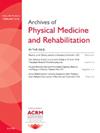Infographics on Sex and Gender Topics in Traumatic Brain Injury to Raise Awareness and Promote Quality Care: A Co-creation Study 1141
IF 3.6
2区 医学
Q1 REHABILITATION
Archives of physical medicine and rehabilitation
Pub Date : 2025-04-01
DOI:10.1016/j.apmr.2025.01.024
引用次数: 0
Abstract
Objectives
To create a series of evidence-based infographics on sex and gender topics in traumatic brain injury (TBI) to improve patient-family member communication and promote gender-transformative care after brain injury.
Design
We used an iterative participatory design consisting of 7 phases: (1) knowledge users’ needs assessment and evidence syntheses; (2) adaptation of content as simple text and visuals; (3) prototype design; (4) feedback from internal stakeholders; (5) infographic revisions; (6) feedback from external stakeholders; and (7) infographic optimization.
Setting
Scientific and knowledge translation activities were carried out at the largest rehabilitation research-teaching hospital in North America. Feedback on infographics was requested at a local, national, and international scale through brain injury organizations and networks.
Participants
People with lived experience of traumatic brain injury, professionals, scientists, and other brain injury and education experts.
Interventions
Not applicable.
Main Outcome Measures
We evaluated the infographics using accessibility measures, including the Flesch Reading-Ease score to assess readability and color contrast criteria as established in the Web Content Accessibility Guidelines. We also sought feedback from internal and external stakeholders on infographic content and design.
Results
We created a total of 6 infographics containing evidence-based information and actionable messages for injury prevention and providing quality care. The infographics contain text in a range of formats, such as paragraphs, lists, and blurbs, complemented by visual elements including cartoons, tables, and diagrams. The materials had an overall Flesch Reading-Ease score of 60.1, which is equivalent to grade 7/8 reading level, and color schemes met Web Content Accessibility Guidelines contrast criteria. The vast majority of participants found that the infographics facilitated understanding of complex topics and that they were useful, engaging, and visually appealing.
Conclusions
Engaging diverse stakeholders in iterative participatory design process facilitates the creation of knowledge translation materials that meet the unique needs of knowledge users, promote equity in information access, and enhance quality of care after traumatic brain injury.
This research was supported by the Cass Family Grants for Catalyzing Access and Change and, in part, Canada Research Chairs Programs (CRC-2021-00074, CRC-2019-00019) and the Global Brain Health Institute (GBHI), Alzheimer's Association, and the Alzheimer's Society UK Pilot Award for Global Brain Health Leaders (GBHI ALZ UK-23-971123). The funders had no role in study design, data collection and analysis, decision to publish, or preparation of the manuscript.
Disclosures
none.
目的制作一系列关于创伤性脑损伤(TBI)患者性别和性别主题的循证信息图表,以改善患者与家属的沟通,促进脑损伤后的性别转化护理。设计采用迭代式参与式设计,包括7个阶段:(1)知识用户需求评估和证据合成;(2)将内容改编为简单的文字和视觉效果;(3)原型设计;(4)内部利益相关者的反馈;(5)信息图修订;(6)外部利益相关者的反馈;(7)信息图优化。科学和知识翻译活动在北美最大的康复研究型教学医院进行。通过脑损伤组织和网络,要求在地方、国家和国际范围内对信息图表提供反馈。参与者:有过创伤性脑损伤经历的人、专业人士、科学家以及其他脑损伤和教育专家。InterventionsNot适用。主要结果测量我们使用可访问性测量来评估信息图表,包括Flesch Reading-Ease评分来评估可读性和颜色对比标准,这些标准在Web内容可访问性指南中建立。我们还寻求内部和外部利益相关者对信息图表内容和设计的反馈。结果我们共制作了6张信息图表,其中包含基于证据的信息和可操作的信息,以预防伤害并提供高质量的护理。信息图表包含一系列格式的文本,如段落、列表和简介,并辅以卡通、表格和图表等视觉元素。这些材料的总体Flesch reading - ease得分为60.1,相当于7/8级的阅读水平,配色方案符合Web Content Accessibility Guidelines的对比标准。绝大多数参与者发现,信息图表有助于理解复杂的主题,而且它们很有用,引人入胜,在视觉上很有吸引力。在迭代参与式设计过程中,让不同的利益相关者参与进来,有助于创建满足知识使用者独特需求的知识翻译材料,促进信息获取的公平性,并提高创伤性脑损伤后的护理质量。本研究得到了Cass Family Grants for Catalyzing Access and Change, Canada research Chairs Programs (CRC-2021-00074, CRC-2019-00019)、全球脑健康研究所(GBHI)、阿尔茨海默氏症协会和阿尔茨海默氏症协会英国全球脑健康领袖试点奖(GBHI ALZ UK-23-971123)的部分支持。资助者在研究设计、数据收集和分析、决定发表或准备手稿方面没有任何作用。
本文章由计算机程序翻译,如有差异,请以英文原文为准。
求助全文
约1分钟内获得全文
求助全文
来源期刊
CiteScore
6.20
自引率
4.70%
发文量
495
审稿时长
38 days
期刊介绍:
The Archives of Physical Medicine and Rehabilitation publishes original, peer-reviewed research and clinical reports on important trends and developments in physical medicine and rehabilitation and related fields. This international journal brings researchers and clinicians authoritative information on the therapeutic utilization of physical, behavioral and pharmaceutical agents in providing comprehensive care for individuals with chronic illness and disabilities.
Archives began publication in 1920, publishes monthly, and is the official journal of the American Congress of Rehabilitation Medicine. Its papers are cited more often than any other rehabilitation journal.

 求助内容:
求助内容: 应助结果提醒方式:
应助结果提醒方式:


